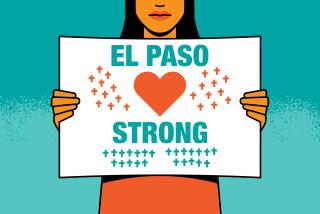Monterrey U.S.A.
- Share via
MONTERREY, MEXICO — When the Kentucky-based Yum Corp. was looking for a city in Mexico in which to open a Taco Bell, it must have figured it couldn’t go wrong with this ultramodern, hyper-Americanized metropolis 125 miles from the Texas border in the northern Mexican state of Nuevo Leon. Regiomontanos, as Monterrey residents are called, wear their pro-Americanism on their sleeves and see little shame in the fact that their streets are as overrun by corporate American retailers as any suburban town north of the border.
Norteño Mexican culture has long been known for its openness to American ways, but Monterrey’s love affair with American consumerism has reached a level that has to be seen to be believed. Bennigan’s, Applebee’s, Dairy Queen, Starbucks, Carl’s Jr., McDonald’s, Pizza Hut, IHOP -- they’re all here. So are Wal-Mart, Hampton Inn, Home Depot, OfficeMax and Bally Total Fitness.
I spent part of Fat Tuesday strolling the aisles of a local H-E-B, a Texas-based big-box store that has brought the Mexican-owned Gigante chain to its knees locally. Three years ago, H-E-B opened a $30-million retail support center here, and the secret of its success, I’m told, is, well, that it’s unabashedly American.
When it first came to Mexico, H-E-B launched a Mexico-specific house brand called Economax, but the company’s market researchers quickly found that Mexican consumers preferred the long-standing American versions. Sure, H-E-B sells sell tortillas, bolillos and traditional Mexican pan dulce, but the brightly lighted, well-stocked aisles generally boasted such items as H-E-B brand chocolate chip waffles, Oscar Meyer bologna, Del Monte tomato paste, Jell-O pudding, Fruit Loops, Gatorade and, much to my surprise, cans of “ranch-style” beans made in the U.S. whose label boasted that they offered “the true taste of the West.”
All these imports do come at a cost, literally. In part because Regios consume so many foreign products, the cost of living here is higher than it is in most other parts of Mexico. But the city’s large middle class doesn’t seem to mind paying the extra price.
In fact, the university students I spoke to here not only bought American products in Monterrey, they crossed the border to outlets in such places as McAllen, Texas. When I asked why, they said goods were cheaper there.
But it doesn’t add up. The cost of gas, the 2 1/2 hour drive on a toll road that costs $60 round trip and the increasingly inhospitable post-9/11 waits -- sometimes three hours -- to cross the international border all suggest that the real reason they love to shop in Texas is status and the idea of the U.S. as the source of the good life.
Just outside the San Pedro district here, which has the highest per-capita income of any community in Latin America, you’ll find some billboards entirely in English. Particularly when discussing entertainment, middle-class Regios like to pepper their Spanish with English. They’ll talk about going to a “lugar muy nice,” they’ll say they’re going to “tomar un break” or “echar unos drinks.”
I met a few transplants from Mexico City who found the Regios’ love affair with the U.S. more than a little offensive. But locals, particularly the young ones, don’t see any problem with living bicultural lives.
“We feel like Mexicans, but we live as Americans,” said Sarahi Garcia, a 22-year-old international relations student at the elite Tecnológico de Monterrey university. The state politicians I met here seemed aggrieved by all the talk in the U.S. of hardening the border. But still, few people I spoke to thought it would ultimately damage the Regios’ strong sense of connectedness with their northern neighbor. The ties are just too deep.
Last September, the governor of Nuevo Leon inaugurated a beautiful Museum of the Northeast, and by the “northeast” they mean the Mexican states of Nuevo Leon, Coahuila and Tamaulipas as well as the U.S. state of Texas. Unlike many U.S. historians and institutions that treat Mexican history as separate from our own, the curators at this museum see the histories of northern Mexico and Texas as being connected not only by war but by shared heritage and intertwined economies. They don’t ignore the reality of the border, but they also don’t pretend that cultural and economic forces don’t flow in both directions.
So does this powerful and historical sense of biculturalism mean that Taco Bell -- with its faux Mexican food -- is destined to thrive in Monterrey? I don’t think so. I went by on Wednesday at lunchtime and ate my Fiestaco -- yes, that’s what it was called -- all by myself.
University student Sofia Ugarte, 18, explained why. “There’s nothing more typically Mexican than tacos,” she said. “That’s one thing that we don’t need to import from the United States. Not even here in Monterrey.”
grodriguez@latimescolumnists.com
More to Read
Sign up for Essential California
The most important California stories and recommendations in your inbox every morning.
You may occasionally receive promotional content from the Los Angeles Times.













